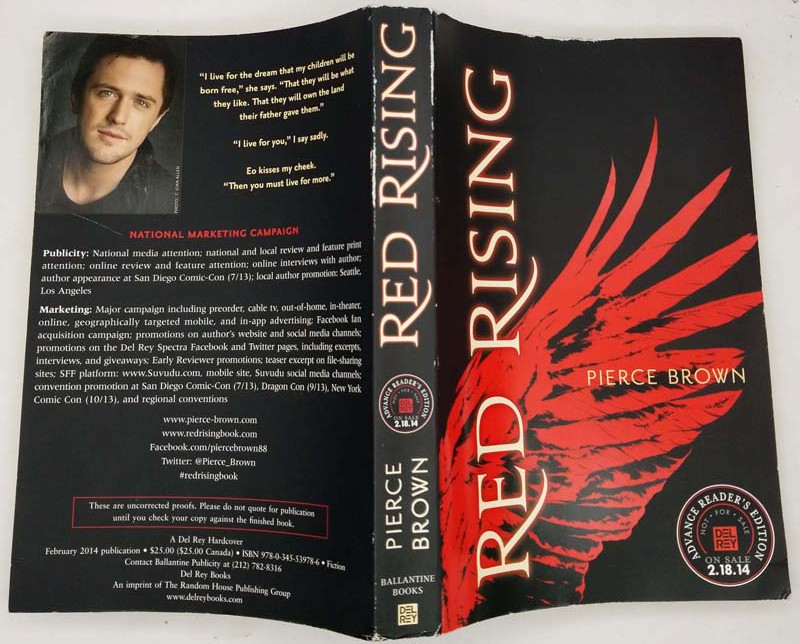Book Review: Red Rising (2013)

Pierce Brown’s Red Rising is an action-packed story about Darrow, an 18 year-old, living in a caste-based world categorized by colors, known as the Society. Science allows for augmenting humans and each color has its role to play. Golds rule with iron fists, Blues are pilots, Greens are technologists, Purples are artists, and so on. Reds, Darrow’s caste color, are the lowest of the low and slave away mining helium-3, which powers the Society. In effect, Reds are slaves digging their lives away so that humans can one day live on Mars’s harsh surface, or so Darrow thinks.
The Bleak Life of a Red
Brown’s imagery gives the reader the bleak perspective of a Red’s life. Mining performance determines what goods each mining group gets. No sympathy if a gas explosion kills half your drilling team, just less provisions till next cycle. Reds aren’t even allowed to bury their dead. Cinnamon and even sugar are not provided to Reds unless their group mines the most in the cycle. A woman may have to sleep with a Grey guard to procure medicine.
Unsurprisingly, living past age 40 is rare for a Red. This cruelty is justified as a necessity since ships ferrying supplies from Earth are expensive and infrequent, or so the Golds tell Darrow and the Reds. Early on, Brown shows his good prose, when Darrow says of his wife, “In her eye, I see my heart. In her breath, I hear my soul.” Family is all a Red has in life. Another good sentence by Brown, “only alone can a boy become a man.”
After tragedy strikes and Darrow narrowly averts death with help from the rebel group the Sons of Ares, he learns the truth. Golds enslave his people and continue to despite Mars already being terraformed hundreds of years ago. Brown’s descriptions of the opulence on Mar’s surface is a great juxtaposition to the horrid conditions in the mines below that power the opulence above.
A Book for Those Into Science Fiction Tech
If you’re into science fiction tech, then this book might be for you. Brown has all sorts of technologies like gravBoots to fly with or pulseShields for protection. The razor particularly is a neat weapon readers will enjoy, like a whip and metal light saber combined into one. Describing how Darrow becomes a gold through scientific augmentation is particularly descriptive.
Brown’s Style Preferences
Brown uses the current tense throughout the Red Rising series. I don’t do this in my writings, but it’s a matter of preference. I can see this style creating a sense of driving forward. Brown also uses short sentences throughout the novel, which reminded me of an early Hemmingway. It helps keep things simple in a story rife with numerous characters and their personalities. Red Rising keeps the reader engaged with good pacing: it seems that a new twist or event happens each page. Twists and turns occur often enough to keep the reader wanting to turn the page. Even the beginning has a decent pace, though not as good as once Darrow gets to the school where Golds are trained to be leaders, the Institute, basically multiple student armies housed in separate forts trying to be the last team standing.
Social Commentary Sprinkled In Without Being Distracting
Brown’s commentary on society makes this book deeper than a simple science fiction story with a good plot. Such commentary is sprinkled enough to not distract the reader, but effective in its delivery. At one point, a Gold teacher says, “Society has three stages: savagery, ascendence, and decadence. The great rise because of savagery, they rule in ascendance, and they fall because of their own decadence.” The same Gold continues, “America died because of its self-loathing and self-neutering.”
The Society started because the Golds in space, “freed themselves from Demokracy, the Noble Lie that all men are created equal.” One Gold calls ancient Athens the birthplace of that cancer Demokracy. The Golds know that jealousy brings down the idea of men created equal. Another Gold proctor at the Institute says that other castes study sciences, like Blues and Greens, but Gold study humanity. “In order to rule, ours must be the study of political, psychological, and behavioral science—how desperate human beings react to one another, how packs form, how armies function, how things fall apart, and why. You can only learn that here (meaning at the Institute). Golds are all realpolitik and even say that empathy is a “lowColor” thing.
Darrow breaks this belief when he allows someone he outranks to punish him for the mistake of the lower ranked student. Darrow knows that leaders should give, not only take, from those they lead. This empathy is key to what Darrow seeks to accomplish in the Society. It’s also a metaphor for politics: start local to gain power, then move on toward more power.
During the endless skirmishes and battles at the Institute, the reader becomes engrossed to the point of forgetting these are young people, merely 18 or 19 year olds, hurting or slaughtering each other. The reader even feels some sympathy for a few Gold participants despite Golds being despotic autocrats who enslave people, such as the poet Roque.
Though the reader knows the atrocities Golds commit, the reader still pains for Gold Institute participants being raped or butchered. Yet Darrow must participate in order to achieve his quixotic goal of saving his people from those tremendously powerful Golds. Some Golds, like Mustang, a character Darrow sees as a different Gold, one with an idea for more than what the Society has to offer in its current form. Still, as one student at the Institute puts it, “Gold is a cold metal,” and Golds for the most part act the pitiless part.
Diversity of Characters
Red Rising has plenty of characters but Brown gives them just enough background for their small part in the story. Sevro, Darrow’s right-hand man, almost steals the show—but maybe I just liked his role and personality.
Best Parts of the Book
The best part of Red Rising, other than its easy readability and creative caste society, is the twists and turns Brown uses to keep the reader wanting more. Credit to Brown for intriguing fight sequences, too. The nascent love story is charming, the nemesis barbaric and inhuman, and the comedy, which there is more than you’d think, makes for an all-around engaging book. It has an element of Ender’s Game to it due to the Institute being one big, bloody game, and Brown even alludes to Orson Scott Card’s masterpiece by naming “Wiggins” in a list of great conquerors, i.e. Ender Wiggins.
Primary Critique
I must point out one critique. There is no explanation to how the Society formed despite numerous religions and adherents on Earth (and assumedly in space) who would object to it and die fighting against it. Darrow at various points says, “If ever I felt there was a God, it is now as I listen to those mournful chords,” “not all sins are forgiven,” and that “God doesn’t come down and mete out justice, the powerful do.” If Brown hadn’t used any religious words at all I wouldn’t have noticed. However, he did, yet failed to explain how the Golds conquered religion. Failing to explain this doesn’t take away from this otherwise exciting book, though it does dent its believability somewhat.
All in all, a fun and creative science fiction book whose ending leaves the reader hungry to know what happens to Darrow next.
